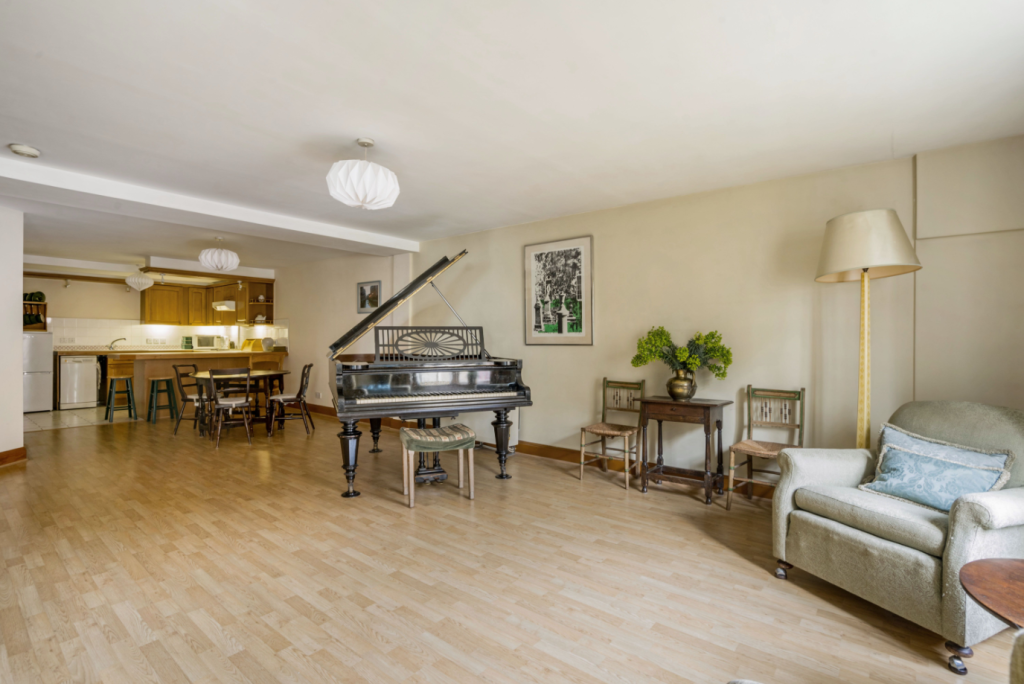Java Wharf is an attractive Grade II listed converted Victorian warehouse occupying a prominent dockside location in the characterful Shad Thames. Set on the western bank of the river Neckinger, a tributary of the river Thames, with long-reaching views along the water through original sash windows and from a private balcony is a magnificent 1,000 sq. ft. one-bedroom apartment, which Is available for £750,000 through Anderson Rose. Benefitting from an abundance of industrial character and charm the history and origin of the site the building rests upon is a captivating tale with links to one of the world’s most infamous moments in English history.
Standing on the western bank of The Neckinger, which was enlarged and embanked by the monks of Bermondsey Abbey in the 13th century, Java Wharf is located on part of the site that was first established as a windmill named The Mill of St. Saviour – after the abbey’s patron saint.
After the dissolution of the monasteries by King Henry VIII in 1536, the windmill was converted into a water mill before being repurposed in 1544 into the first water-powered gunpowder factory in England to support the country’s war with France.
The factory produced the bulk of gunpowder and munitions that were loaded onto the Mary Rose, King Henry VIII’s flagship. Originally a carrier ship to transport soldiers into battle on foreign lands, the impending invasion from France led the King to repurpose the ship, along the River Thames on the London Medway, to add more gunports and increase its loading capacity.
This refit and overloading of cannons, guns, munitions and powder barrels has been provided as one theory behind the ships sinking on the Solent in 1545 when sailing out and turning sharply to face enemy French ships that had been docked on the Isle of Wight ahead of a failed plot to invade the country.
The gunpowder mill on Java Wharf continued to operate until the mid-1700s when it was closed, and the building was abandoned. It was then rebuilt as a paper mill and by the middle of the 19th century, the site was occupied by lead mills. The building currently occupying Java Wharf replaced the former mill and was utilised as a warehouse to house the burgeoning produce being brought into London from across the British Empire.
The area’s industrial prominence declined in the 20th century, partly due to congestion and partially because ships were unloading further east along the river into containers. Since the 1980s the warehouses, such as Java Wharf, that line the river Neckinger have been converted for residential use yet retained their original features characteristic of their former use, such as bare-faced brickwork, winches and large signwriting, which have produced a collection of unique and characterful homes.
This spacious one-bedroom apartment set within the historic Java Wharf provides over 1,000 sq. ft. of charming accommodation characterised by original features and captivating river views through warehouse windows and from a private balcony, which opens from both the bedroom and the living room.
Entered via a central hallway, with extensive built-in storage, double doors lead onto a large open-plan double main reception room with an extensive fitted kitchen with a breakfast bar and a sizeable pantry. The bedroom spacious bedroom can be accessed from the hallway or via the balcony from the reception room. A generous bathroom completes the home.
Residents of this Grade II listed building also enjoy access to a large roof terrace that enjoys breath-taking panoramic views across the London skyline.
Located moments from the Tower Bridge waterfront, Java Wharf is close to popular boutique restaurants, cafes and shops, whilst The City of London is a short walk across Tower Bridge. London Bridge station (Jubilee line and mainline rail services) is also close by.
Jon Byers, Founder of Anderson Rose, commented: “The beauty of this prominent stretch along the river Thames is its history and character that runs deep through the fabric of the city’s story. Homes within the unique former industrial buildings that characterise the area provide their owners a sense of occupying a piece of the city’s legend. Java Wharf is one of the area’s most intriguing buildings and has a wealth of features that make it a fantastic place to call home, with the rare benefit of private outside space and views directly onto the water.”
This characterful one-bedroom apartment within Java Wharf is available for £750,000. For further sales information, contact Anderson Rose on 020 3324 0188 or visit www.andersonrose.co.uk



